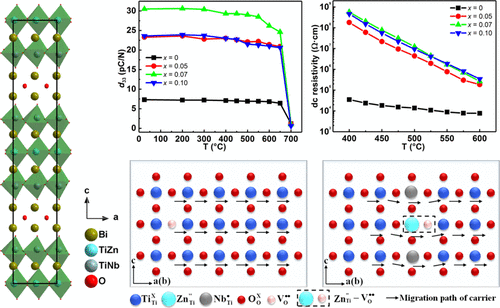当前位置:
X-MOL 学术
›
ACS Appl. Mater. Interfaces
›
论文详情
Our official English website, www.x-mol.net, welcomes your
feedback! (Note: you will need to create a separate account there.)
Ion-Pair Engineering-Induced High Piezoelectricity in Bi4Ti3O12-Based High-Temperature Piezoceramics
ACS Applied Materials & Interfaces ( IF 8.3 ) Pub Date : 2022-03-16 , DOI: 10.1021/acsami.1c19445 Xinchun Xie 1, 2 , Zhiyong Zhou 1 , Botao Gao 3 , Zhengyang Zhou 3 , Ruihong Liang 1 , Xianlin Dong 1, 3, 4
ACS Applied Materials & Interfaces ( IF 8.3 ) Pub Date : 2022-03-16 , DOI: 10.1021/acsami.1c19445 Xinchun Xie 1, 2 , Zhiyong Zhou 1 , Botao Gao 3 , Zhengyang Zhou 3 , Ruihong Liang 1 , Xianlin Dong 1, 3, 4
Affiliation

|
High-temperature piezoceramics are highly desirable for numerous technological applications ranging from the aerospace industry to the nuclear power sector. However, it is a grand challenge to achieve excellent piezoelectricity and high Curie temperature (Tc) simultaneously because there is a contradiction between the large piezoelectric coefficient and high Curie temperature in piezoceramics. Here, we provide a perspective via B-site ion-pair engineering to design piezoceramics with high performance for high-temperature applications. In bismuth-layered Bi4Ti2.93(Zn1/3Nb2/3)0.07O12 ceramics, high piezoelectricity of d33 = 30.5 pC/N (more than four times higher than that of pure Bi4Ti3O12 (d33 = 7.3 pC/N) ceramics) in conjunction with excellent thermal stability, high Curie temperature Tc = 657 °C, and large dc resistivity of ρ = 1.24 × 107 Ω·cm at 500 °C (three orders of magnitude larger than that of the pure Bi4Ti3O12 ceramics) are achieved by B-site Nb5+-Zn2+-Nb5+ ion-pair engineering. Excellent piezoelectricity is ascribed to sufficient orientation of the fine lamellar ferroelectric domain with the introduction of Nb5+-Zn2+-Nb5+ ion-pairs. The good temperature stability of d33 originates from the stability of the crystal structure and the robustness of the oriented ferroelectric domain. The significantly improved resistivity is due to the restricted mobility of oxygen vacancies. This work presents a brand-new technique for achieving high-temperature piezoceramics with high performance by B-site ion-pair engineering.
中文翻译:

离子对工程诱导 Bi4Ti3O12 基高温压电陶瓷的高压电性
高温压电陶瓷对于从航空航天工业到核能领域的众多技术应用来说是非常理想的。然而,由于压电陶瓷的大压电系数和高居里温度之间存在矛盾,同时实现优异的压电性和高居里温度(Tc)是一项巨大的挑战。在这里,我们提供了通过 B 位离子对工程设计用于高温应用的高性能压电陶瓷的视角。在铋层状Bi 4 Ti 2.93 (Zn 1/3 Nb 2/3 ) 0.07 O 12陶瓷中,d的高压电性33 = 30.5 pC/N(比纯Bi 4 Ti 3 O 12 ( d 33 = 7.3 pC/N) 陶瓷高四倍以上)以及优异的热稳定性,高居里温度T c = 657 °C,B位Nb 5+ -Zn 2+实现了在500°C时ρ = 1.24 × 10 7 Ω·cm的大直流电阻率(比纯Bi 4 Ti 3 O 12陶瓷大三个数量级) -铌5+离子对工程。优异的压电性归因于通过引入Nb 5+ -Zn 2+ -Nb 5+离子对的细层状铁电畴的充分取向。d 33良好的温度稳定性源于晶体结构的稳定性和定向铁电畴的稳健性。显着提高的电阻率是由于氧空位的受限迁移率。这项工作提出了一种通过B位离子对工程实现高性能高温压电陶瓷的全新技术。
更新日期:2022-03-16
中文翻译:

离子对工程诱导 Bi4Ti3O12 基高温压电陶瓷的高压电性
高温压电陶瓷对于从航空航天工业到核能领域的众多技术应用来说是非常理想的。然而,由于压电陶瓷的大压电系数和高居里温度之间存在矛盾,同时实现优异的压电性和高居里温度(Tc)是一项巨大的挑战。在这里,我们提供了通过 B 位离子对工程设计用于高温应用的高性能压电陶瓷的视角。在铋层状Bi 4 Ti 2.93 (Zn 1/3 Nb 2/3 ) 0.07 O 12陶瓷中,d的高压电性33 = 30.5 pC/N(比纯Bi 4 Ti 3 O 12 ( d 33 = 7.3 pC/N) 陶瓷高四倍以上)以及优异的热稳定性,高居里温度T c = 657 °C,B位Nb 5+ -Zn 2+实现了在500°C时ρ = 1.24 × 10 7 Ω·cm的大直流电阻率(比纯Bi 4 Ti 3 O 12陶瓷大三个数量级) -铌5+离子对工程。优异的压电性归因于通过引入Nb 5+ -Zn 2+ -Nb 5+离子对的细层状铁电畴的充分取向。d 33良好的温度稳定性源于晶体结构的稳定性和定向铁电畴的稳健性。显着提高的电阻率是由于氧空位的受限迁移率。这项工作提出了一种通过B位离子对工程实现高性能高温压电陶瓷的全新技术。


















































 京公网安备 11010802027423号
京公网安备 11010802027423号